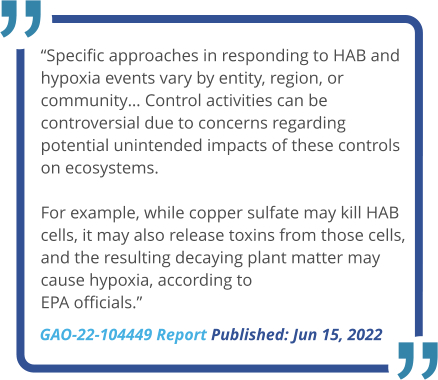EXCESSIVE ALGAE GROWTH
HOW DOES EUTROPHICATION CAUSE EXCESSIVE ALGAE GROWTH?
Eutrophication is a major driver of excessive algae growth in water bodies. As nutrient accumulate in the sediment and are recycled algae populations can rapidly expand, leading to algal blooms.
In a eutrophic system, the nutrient-rich water promotes the growth of phytoplankton, particularly algae. When the algae population grows faster than the food web can consume it, an imbalance occurs.
The excess algae eventually die off and sink to the bottom, where they decompose, consuming oxygen in the process. This leads to hypoxic conditions in the lower water column and sediment, which impairs the food web and reduces the natural controls on algae growth.
As the algae decompose, they contribute to the accumulation of nutrient-rich sediment, which further fuels the cycle of eutrophication and algae growth through nutrient recycling.
IS EXCESSIVE ALGAE GROWTH A PROBLEM, AND IS IT IMPORTANT?
Excessive algae growth is a significant problem in eutrophic water bodies because accelerates and exacerbates sediment nutrient accumulation and recycling and disrupts the natural balance of the aquatic ecosystem. Algal blooms can lead to a variety of negative consequences, including:
1. Reduced water clarity and increased turbidity
2. Oxygen depletion in the water column, leading to fish kills and the loss of other aquatic life
3. The proliferation of cyanobacteria and release of toxins, which can harm humans and animals
4. Reduced recreational value of the water body and decreased aesthetic appeal
5. Increased water treatment costs for drinking water supplies
Addressing excessive algae growth is crucial to maintaining the health and functionality of aquatic ecosystems and protecting human health and economic interests.
WHAT IS THE WRONG WAY TO GO ABOUT TRYING TO FIX THE PROBLEM?
A common but misguided approach to controlling excessive algae growth is the use of algaecides.
While algaecides may provide temporary relief by killing the visible algae, they do not address the root cause of the problem. When the treated algae die off, they sink to the bottom and decompose, contributing to the accumulation of nutrient-rich sediment and further fueling the cycle of eutrophication.
Ultrasonic algacidal devices are no different to toxic chemical treatments in this regard.
The repeated use of copper sulfate over many years has be known to cause accumulation of copper in the sediment to the point where physical dredging cannot be permitted because the levels of this heavy metal in the sediment mean it cannot be safely disposed of in compliance with environmental regulations.
Moreover, the use of algaecides can have unintended consequences on the aquatic ecosystem. They may harm non-target species, disrupt the food web, and even lead to the release of toxins from certain types of algae, such as cyanobacteria.


HOW DO YOU FIX THE PROBLEM?
We take a holistic approach to controlling excessive algae growth by addressing the root causes of eutrophication. We focus on restoring the natural balance of the aquatic ecosystem through a combination of RADOR oxygenation technology and bioaugmentation.
By oxygenating the water column and sediment, we create conditions that support the restoration of the food web by promoting the consumption of algae by zooplankton and higher levels of the food web.
By addressing the underlying causes of excessive algae growth and working with nature to restore balance, CLEAN-FLO INTERNATIONAL offers a sustainable and environmentally friendly solution to the problem of algal blooms in eutrophic water bodies.
Download the Lake Management ACTION Plan E-Book
Ready to explore how oxygenation can transform your lake? Download Clean-Flo’s Lake Management ACTION Plan E-Book to learn more about our innovative solutions, real-world results, and how we can help restore and protect your lake.
